Coat of arms Flag Local time Thursday 4:10 PM | Area 49 km² | |
 | ||
Administratively subordinated to Borisoglebsky Urban Okrug Administrative center of Borisoglebsky Urban Okrug Urban okrug Borisoglebsky Urban Okrug Weather 3°C, Wind S at 14 km/h, 77% Humidity | ||
Borisoglebsk (Russian: Борисогле́бск) is a town in Voronezh Oblast, Russia, located on the left bank of the Vorona River near its confluence with the Khopyor. Population: 65,585 (2010 Census); 69,392 (2002 Census); 72,338 (1989 Census); 65,000 (1969).
Contents
- Map of Borisoglebsk Voronezh Oblast Russia
- History
- Administrative and municipal status
- Military
- Notable people
- Twin town
- References
Map of Borisoglebsk, Voronezh Oblast, Russia
History
It was founded in 1646. It is named for the Russian saints Boris and Gleb.
In 1870, Brewery #4 Klinsmann was opened. The plant produces dark and light beer, as well as fruit soda. With the advent of Soviet power plant continued to operate in its original form. In the middle of the 20th century, the company has been upgraded, new shops built and launched new lines. Currently, the company is going through hard times, but continues to produce beer.
In Borisoglebsk in the early 20th century there was a very busy marina, on the proximity to Chopra named Khopyorskaya. Back in the 1870s in the local pier was loaded more than 52 million m3 of grain and flour in Borisoglebsk on the meadow side Chopra and Ravens are built annually to two thousand barges, send the goods to Rostov and Taganrog; here every year before, to 10 thousand boatmen. Dirt - holding Tsaritsin road Borisoglebsk contacted Tsaritsyn and, therefore, with the edge of the Volga on the one hand and with the ports of the Baltic Sea on the other, and quickly became one of the busiest points hlebotorgovyh Black Earth region, through which were sent to St. Petersburg and Moscow, grain, timber, kerosene, fish, eggs, watermelon and salt lakes of the Astrakhan province, which supplies the entire area of the railway.
According to the 1885 population Borisoglebsk 13,007 inhabitants (6,325 males and 6,682 females), almost exclusively Russian Orthodox. In Borisoglebsk in the early 20th century there was a female (4- class ) and the men (6 classes ) gymnasia, technical railway school, 2 urban parish school fairs, etc. From then stood Kazan (July 6), lasted 3 days, having important ( local) economic value.
After the Bolsheviks came to power in 1918 in Borisoglebsk concentration was organized by one of the first concentration camps in Russia for "alien and petty-bourgeois elements".
In December 1922, Borisoglebsk was created 2nd Military School Red Air Force pilots which became later, the renowned Borisoglebsk Higher Military Order of the Red Banner of Lenin School for Pilots Chkalov.
Administrative and municipal status
Within the framework of administrative divisions, it is, together with twenty-four rural localities, incorporated as Borisoglebsky Urban Okrug—an administrative unit with the status equal to that of the districts. As a municipal division, this administrative unit also has urban okrug status.
Military
The town is host to Borisoglebsk air base.
Notable people
The famous Bolshevik revolutionary Ivan Fioletov, one of the 26 Baku Commissars, was born here.
Maria Spiridonova, another Russian revolutionary, assassinated Police Inspector General G. N. Luzhenovsky at the Borisoglebsk railway station in January 1906.
